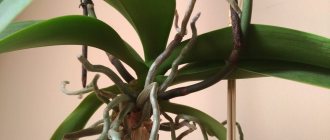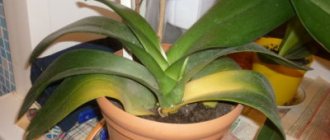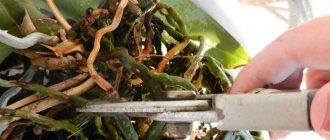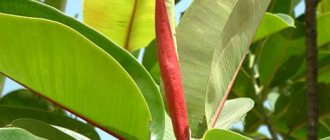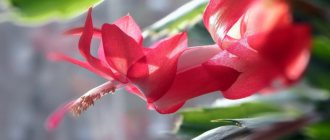Monstera is a plant from the Araceae family, native to the tropics. It is an evergreen vine with thick stems and aerial roots. Contrary to popular belief that the crop is poisonous, it does not pose a danger to people or animals. Getting juice on exposed skin can only cause irritation, however, it is not edible.
Monstera often grows large aerial roots.
When growing monstera at home, you often have to deal with the problem of overgrown aerial roots, which make it difficult to move the pot or water the plant. In addition, the vine begins to take up too much space.
In such a situation, the question arises: is it possible to cut off the aerial roots of a monstera? In this case, the opinions of flower growers differ; some carry out this procedure regularly, while others prefer to look for other ways out of the situation.
On a note. It is important to know that after removing the aerial roots, the growth of Monstera slows down significantly, and sometimes stops altogether.
How to recognize aerial roots
Before deciding what to do with the proverbial roots, they need to be recognized. An inexperienced gardener may decide that these are not roots, but new stems. Aerial roots form on the stems as the plant grows. As a rule, they grow opposite the leaves and have a slightly thickened, woody structure. Such shoots are colored not green, like the main stem, but light brown. Often such roots grow to an impressive length, “spreading” onto the floor near the pot.
What are they needed for
Aerial roots for indoor monstera are an additional tool for obtaining moisture: under natural conditions, this tropical plant grows in a climate zone where heavy warm rains often occur, and therefore the air is extremely saturated with moisture. Thanks to aerial roots, the vine can receive additional moisture not only from the soil, but also directly from the surrounding air, which is of great importance for the normal development and full life of the plant.
There is a direct relationship here: the more aerial roots a vine has, the more powerful, beautiful and healthy it will be. And under particularly favorable conditions, it can even please you with flowering. So aerial roots are certainly a necessary organ for a tropical beauty.
Apical cuttings
The best period for propagation by apical cuttings is spring-summer. To do this, use a sharp knife to cut off the top of the stem, which has 2-3 leaves. If such a cutting has an aerial root, the process of rooting and growth will be significantly accelerated.
The cutting is placed in water, the temperature of which should not be lower than 25 degrees, and placed in a well-lit place without the scorching rays of the sun.
When planting, you should wait until the cutting has at least 3 roots. The more such root processes, the faster the monstera will take root and produce young leaves.
What to do with the roots
We figured out that the aerial roots of Monstera are far from being a useless organ. And yet, when grown at home, they pretty much spoil the overall picture, hanging with ugly brown shoots all the way to the floor, giving the plant an unkempt and unkempt appearance. To correct the situation, there are several ways to deal with annoying roots:
- you can carefully tie the roots to the main stems as they form, so that they gradually reach the ground and can take root on their own;
- or place a couple of more pots with soil near the container with the monstera, and direct the root shoots into them. Then after rooting you will get several more young vines;
- You can place bottles of water so that rooting occurs not in the soil, but in the water. In this case, it is important not to forget to change the water to fresh water on time;
- some wrap the roots in damp moss. This option adds aesthetics and allows the rooting process to begin;
- Gardening stores often sell special plastic supports decorated with dried palm fiber. An overgrown vine can be fixed on such a support by making small holes in it to secure the aerial shoots. Sometimes such holes are filled with earth or simply sprayed regularly from a spray bottle;
- The aerial root shoots of the vine can simply be trimmed. True, not all, and not completely. The plant will not be harmed if you remove a small part of all the aerial roots, or shorten them slightly to give the composition a more attractive appearance. Of course, you should not remove absolutely all the shoots - in this case, the monstera may get sick or even die. The least problem you will encounter in this case is yellowing of the leaves and decreased vitality of the plant.
So there are many safe and effective ways to transform your tropical beauty. The main thing is not to get rid of the shoots as soon as they appear. If nature provides such an organ, then the plant needs it.
Just watch the growth of the roots and direct them where you need them in time. This way you will protect your monstera from diseases and give your favorite flowerpot a truly elegant and blooming look.
Video “Transplanting indoor monstera”
From this video you will learn how to properly transplant an indoor monstera.
According to experts, the described monstera roots help obtain additional moisture. The tropical monstera vine grows naturally in the hot tropics, where there is often heavy rain and the air is oversaturated with life-giving moisture.
Thanks to its well-developed aerial roots, the plant can receive moisture not only from moist soil, but also from the air. The moisture obtained in this way has a beneficial effect on the development of the exotic plant.
Experts say that there is a direct relationship: the longer and denser such roots are, the healthier and stronger the monstera will grow.
When creating favorable conditions for the development of a flower, sometimes an obstinate beauty can please with its unusual flowering. The correct development of the vine will become absolutely impossible if it is deprived of this device.
An interesting opinion is that such roots are important not only for the growing plant, but also for its owner. Based on the condition of the roots, an experienced gardener will always be able to determine the condition of the vine in one or another phase of its development.
Taking into account the above arguments, we can come to the conclusion that these roots are vital organs of the plant.
What is recommended to do with aerial roots?
Aerial roots bring many benefits to the plant; they enrich it with valuable moisture, which is necessary for the harmonious development of the vine.
But when growing a flower at home, these shoots can ruin the appearance of the monstera.
Over time, they become very long, and hanging untidy from the flower hill, they create an unkempt appearance.
Carefully tying them to the stems during the formation of the plant helps to reach soil shoots in which they can take root.
Near the flower pot in which the monstera is placed, you can place several small containers filled with soil. Such roots can be directed into these containers, and over time they will take root in them. After rooting, the gardener will have several young exotic plants.
Next to the monstera flower pot you can place several containers filled with settled water. This will promote rooting in water. When using this method, a novice gardener must remember that for good development it is necessary to change the water every three days.
Some experienced gardeners recommend wrapping the shoots with moss soaked in water. This method will add aesthetics to the appearance of the plant and speed up the process of natural rooting.
In special flower shops you can purchase plastic supports made to decorate the appearance of vines. Monstera is easily fixed in such a support; the air shoots (as in the picture below) are brought inside the support through small holes.
Monstera with aerial roots
When choosing this method, it is more important not to forget to spray the holes through which the aerial roots pass with a spray bottle.
The above methods do not involve cutting off the aerial shoots of a tropical vine.
But sometimes gardeners improve their appearance by partially cutting off untidy shoots that are growing and sticking out in different directions.
When using this method, it is important to remember that it is absolutely impossible to cut off absolutely all shoots. In this case, the plant will not be able to continue its development and will soon die.
Monstera will not suffer much if several of these roots are partially shortened. But such an operation can contribute to the appearance of yellow spots along the edges of the carved leaves of the vine.
The desire to grow a beautiful tropical plant in your home is quite real. Monstera will be a worthy decoration of any interior. When growing it, you should be careful with the shoots from its stems, which are vital for the plant.
While watching the video you will learn about caring for the monstera.
Monstera - in the photo
Monstera - home care, replanting, watering, maintaining temperature
One of the most popular decorations for spacious halls and offices is Monstera, which is easy to care for at home due to its unpretentiousness, but requires the use of certain knowledge and effort.
This tropical guest is not only beautiful, but also useful - it can ionize the air. Monstera grows up to six meters, so it needs space - it also needs good lighting, but should be protected from direct sunlight. With a lack of light, the monstera withers and the foliage loses its decorative effect.
The ideal temperature for monstera in summer is up to +25 °C, in winter +16 °C...+18 °C, it grows in the humid climate of the tropics, so it needs spraying - monsteras regularly wipe off dust from the wide leaves and wipe them with milk and water to restore shine.
The vine is replanted as it grows - up to three years every year in the spring, then every three years. The soil is no different from the substrate that is suitable for most indoor plants - a mixture of turf soil with sand, compost and peat, but good drainage is important. In winter, monstera is watered approximately once every two weeks, in the spring and summer months - more often, as the soil dries out with soft warm water.
Fertilizing monstera with complex fertilizers is necessary from April to August, once every two weeks. It is useful to alternate root and foliar feeding, but it is also advisable to add organic matter - mulch from leaf humus, since when the monstera goes hungry, it slows down its growth.
monstera - in the photo
Monstera domestica - in the photo
There is a widespread idea of monstera as a poisonous plant - the juice of its leaves and stems can cause skin irritation, nothing more, but, of course, it is inedible for either people or domestic animals.
Seeds
The seed propagation method is very long and labor-intensive.
Only fresh seeds are used for sowing, since over time they lose their viability. The optimal way to germinate seeds is in plastic bags filled with 5% damp sphagnum moss (the rest of the space is air).
The bags should be kept in a place with a good level of indirect light and a temperature of 25-28 degrees. The first shoots appear after 30-50 days.
Strong seedlings are transplanted into a mixture of leaf, turf soil and sand. Their growth and development is slow. By 2 years, the plant will have up to 5 juvenile leaves (without slots) and about 4 adult leaves.
Methods for propagating monstera at home
There are several ways in which monstera reproduces - home care includes trimming the shoots for planting material:
- Apical cuttings - cut off the top of the monstera and place it in water, and when the cutting has developed a sufficient number of roots, you can plant it in a pot;
- Stem cuttings - simply place a piece of a monstera stem with at least two buds on the surface of the soil in a pot under film or glass, ventilate the greenhouse from time to time, water and spray the cutting, and when it takes root and leaves appear, transplant it to a permanent place;
- Leaves - if you happen to get a monstera leaf, try putting it in water and waiting for the roots to appear - this method is not very reliable, since the leaf most often dies, but it also has a right to exist;
- Lateral shoots - appear at the base of the monstera stem, they are separated, the cut is sprinkled with charcoal and transplanted into soil made of sand, peat and humus, covered with a bag. The cuttings are watered and ventilated until young shoots appear;
- Stem cuttings with aerial roots - if aerial roots emerge from the side shoot of the monstera, try to develop them; to do this, you can wrap them in damp moss and tie a film on top so that the moisture does not evaporate. You can also tie a cut plastic bottle to the shoot, pour water into it and lower the roots - when they grow, separate the shoot from the main stem with a sharp knife and transplant it into a separate container;
- Seeds - this method is rarely used, but if you have monstera seeds, sow them in a peat and sand substrate, maintain the temperature around +20 °C...+25 °C. When the shoots appear after 2-4 weeks, wait for the first true leaf and plant them in separate containers.
A rare plant looks as exotic as a monstera, caring for which at home can lead to its disease and death only if basic rules are not followed - an acute lack of light, too dry air, waterlogging of the soil in the pot, which causes the roots to rot. But in general, this is a hardy plant that pleases the eye for many years.
Stem cutting
This is the most convenient and easiest way of reproduction.
The optimal time for this is spring-summer. A part of the stem with at least 2 buds is separated from the mother plant. Then such a cutting is laid on the ground so that one of its buds touches the surface.
Do not deepen or cover a piece of the stem with soil. It will take root easily if you provide regular watering, warm maintenance and spraying. It is recommended to use a lightweight substrate (preferably) or a container with hydrogel.
In order for the Monstera cuttings to take root better and faster, you should make a mini-greenhouse for it . To do this, the container is covered with a jar, glass or polyethylene to create the necessary microclimate. The “greenhouse” should be ventilated periodically.
After rooting, the stem cutting can be transplanted to a permanent place in an individual pot. The first young leaves will be heart-shaped and only after some time will they become dissected.
Monstera at home
Monstera , a plant so unusual and grandiose that it can literally and figuratively outshine all other indoor plants. Dieffenbachias, yuccas, most palm trees and other indoor giants, in comparison with the monstera, do not seem so big. It is possible to grow such a plant in a small apartment, but for this you will have to sacrifice a decent piece of living space. Monstera is a flower for spacious rooms, and it is there that it not only looks harmonious, but also develops much better, and therefore looks more beautiful.
Although caring for a monstera at home is not particularly difficult and the plant is considered unpretentious, even if you have a room the size of a football field, without knowing the basic rules of maintenance, it is unlikely that you will be able to grow a beautiful plant.
Why do monstera leaves turn yellow - diseases and pests
The reason why a flower begins to hurt or is affected by pests is that it is kept in unfavorable conditions.
Errors in care weaken the monstera; it does not receive important substances or, on the contrary, takes them in excess. Important! Sometimes owners lose sight of the fact that in winter (from late autumn to early spring) watering needs to be significantly reduced and they continue to give the plant the summer amount of water.
Diseases can be caused by a lack of water, the wrong location, too little or too much sun, unsuitable temperature or humidity. Pests may settle on the plant. Especially if outdoor contaminated soil was used for replanting.
Monstera: home care
Lighting
This plant requires quite a lot of light. I have often seen monsteras growing “one-sidedly”, in one direction. Of course, this side was the source of light. While the plant is small, providing it with uniform lighting is not particularly difficult. When the monstera grows, it becomes more and more difficult to find a suitable place for it. A great place for a monstera is the corner between two windows. There she will receive relatively uniform lighting and at the same time be protected from direct sunlight. It is believed that monstera can grow in partial shade. It can really grow. But in order for monstera leaves to acquire their unique “holeiness”, enough light is required. You need to decide on a place for the plant right away. And if not forever, then at least for a long time. It doesn't like changes. Lack of light also stops the growth of leaves; they grow small. The aerial roots of Monstera react in the same way. They become thin and stunted.
See also:
| Monstera I read a question about monstera on the site and remembered that I have an article about it on Ju. Here I copied it Don't be afraid, these are good monsters! Don't be afraid, these are good monsters! I don't want to wake up. There is no sun. Yesterday it was. It’s gone, rolled over the horizon and can’t find its way back. A gloomy, hopelessly gloomy morning. Did someone sob? It can't be, I'm alone... Read more" |
| My monstera This is my monstera!!! She just screams and asks to be transplanted! And I still have no time!!! Finally, I am ready for this event, and therefore I am ready to accept all the useful advice that the lovely haciendas will offer me. Your experience is enormous, but I can’t figure out what to do with a bunch of hanging roots!!! |
| What, how and when to trim? Please tell me, share your experience in pruning fruit trees and shrubs. I'm completely confused. Who says you can’t go in the spring, the juice goes where you were in the fall. Who says that you can’t do it in the fall, because they’ll freeze... So I’m surfing the Internet looking for information with a lot of thoughts in my head. To do what??? |
| About monstera and wintering chrysanthemums. At the beginning of summer, I moved my monsteras into larger pots, I thought they would immediately begin to grow and new leaves would appear, but several months have passed and only now a new leaf appears on one monstera. But the old leaves began to turn yellow and have these brown spots on them. Please tell me, dear haciendas, what is missing in my monsters? What fertilizer is best to water... Read more" |
| THIS IS THIS MONSTER VARIEGATA I waited a long time for the leaf to turn white... and now the effect of the white spot on the leaf is obvious! the leaves of the second plant are not yet white |
